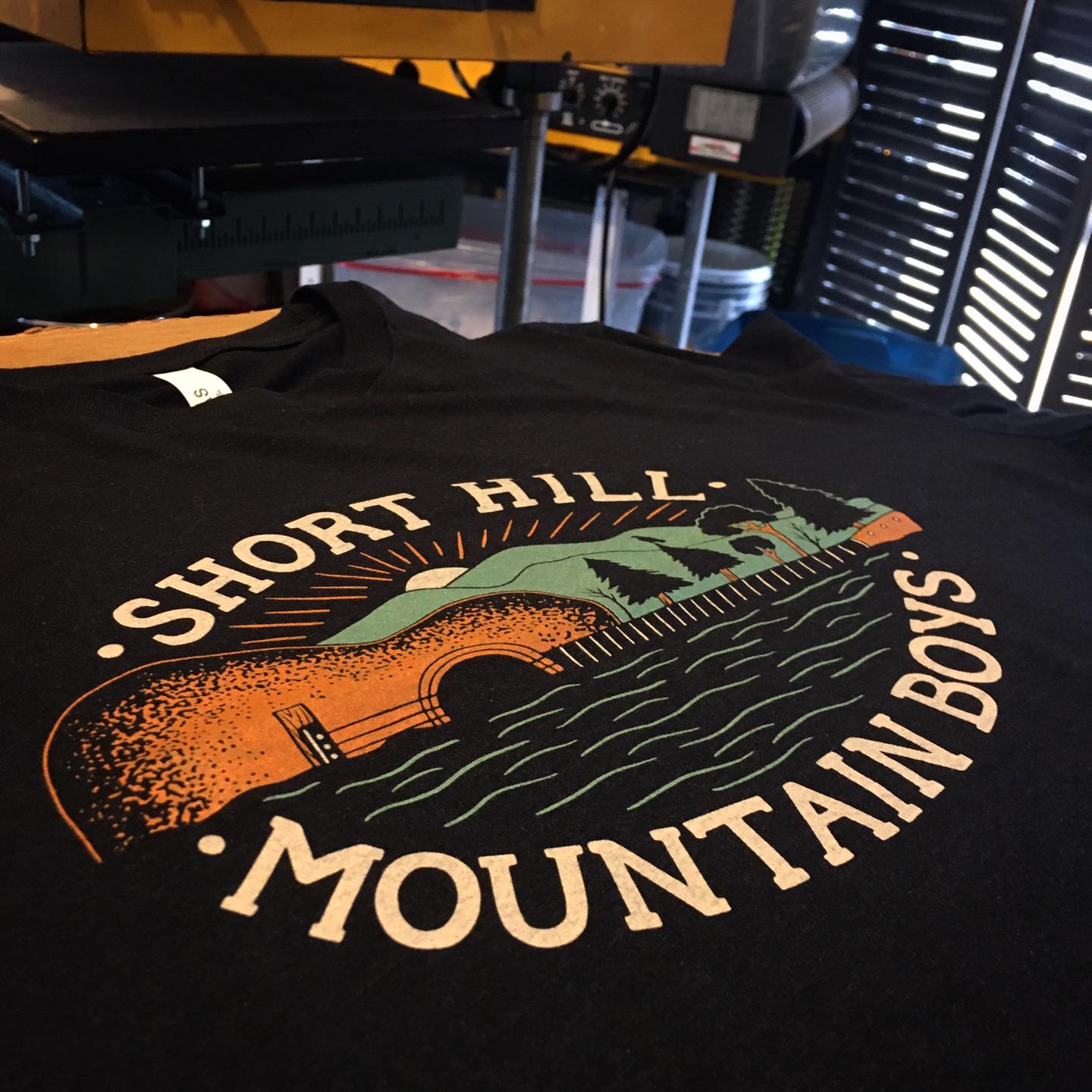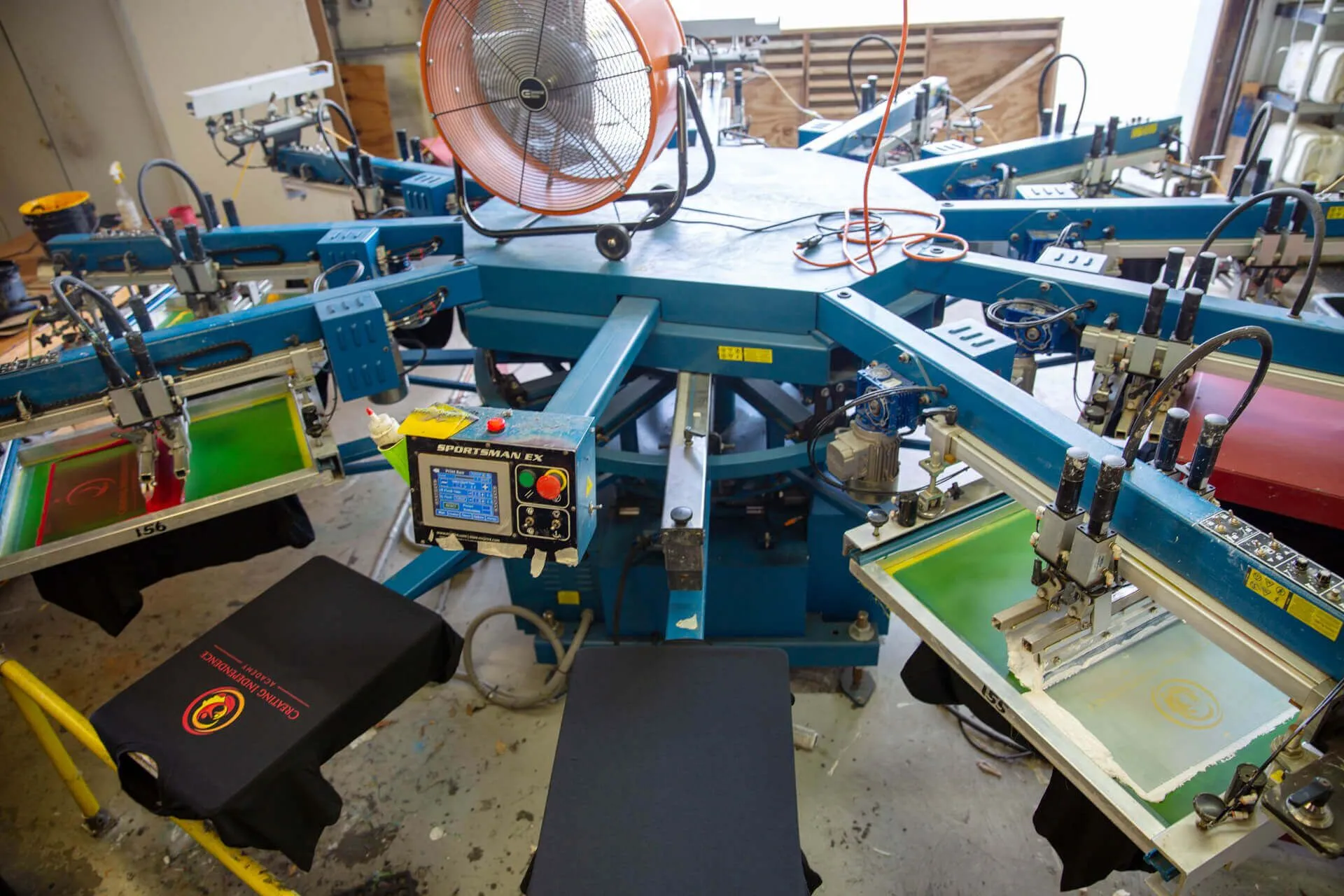High-Quality Custom Screen Printing for Team Apparel
Wiki Article
Screen Printing Uncovered: Everything You Required to Find Out About Tee and Garment Printing Methods
Screen printing is a fascinating approach that combines art with method, offering limitless possibilities for creative thinking. Ready to discover the important aspects that make screen printing an art form?
The Basics of Display Printing: How It Functions
When you plunge right into screen printing, you'll find it's both a scientific research and an art. At its core, display printing entails producing a stencil, or display, that permits ink to travel through only in details locations (screen printing kit). You start by selecting your layout and preparing your screen with a light-sensitive emulsion. Once you reveal this emulsion to light, it sets, leaving your style as an unfavorable area.Next, you'll blend your inks and prepare your printing surface. Setting the screen over the textile, after that use a squeegee to push ink with the display onto the garment. This process calls for precision, as you desire clear, lively prints. After printing, you'll treat the ink with warm, guaranteeing it sticks to the textile and lasts with cleans. Each step is crucial, and understanding them will certainly elevate your screen printing abilities, transforming straightforward garments into unique, expressive pieces.
Types of Display Printing Techniques
When you realize the fundamentals of display printing, it's time to explore the numerous techniques that can raise your designs. One popular method is typical display printing, where ink is pressed through a stenciled screen.If you're going for fine details, consider discharge printing. This method gets rid of dye from the textile, leaving a soft, classic look. One more option is plastisol printing, known for its durability and dazzling shades, making it a favorite for lots of brands. Finally, experiment with halftone printing to produce gradient results and elaborate layouts. Each method has its distinct charm, so don't hesitate to attempt them out to find what fits your style best!
Essential Tools for Display Printing
To accomplish stunning outcomes in display printing, having the right tools is essential. You'll need a tough display printing frame, which holds the mesh that transfers your layout onto the garment. Next off, purchase high-grade squeegees; these are important for applying ink evenly across the display. You'll also need a good direct exposure unit to develop your displays, along with a washout booth for cleansing them after use. A trustworthy heat source, like a conveyor clothes dryer or heat press, is critical for healing your prints to ensure longevity. Do not neglect a correct work area, geared up with tables and storage space for your supplies. Safety gear, such as handwear covers and masks, will keep you risk-free from chemicals and inks. With the right devices, you'll be well on your way to producing professional-quality prints.Selecting the Right Inks and Materials
When selecting inks and materials for display printing, you need to take into consideration the type of ink that works finest for your project. Think concerning fabric compatibility to ensure your layouts look wonderful and last long. Also, discover environmentally friendly ink options to make your printing process much more sustainable.Sorts Of Display Inks
Choosing the ideal display ink is vital for accomplishing dynamic, resilient prints that fulfill your project's needs. There are a number of kinds of display inks to take a look at. Specialized inks, such as glow-in-the-dark or metallic, can include unique results to your layouts.
Fabric Compatibility Considerations
Comprehending material compatibility is vital for attaining high-grade display prints, particularly given that various materials react distinctly to various inks. Constantly test your inks on sample fabric to ensure they adhere properly and maintain shade honesty. In addition, keep in mind that textile weight and texture can impact the final result, so selecting the right ink and material combo is important for your project's success.Eco-Friendly Ink Options
Environmentally friendly inks are becoming a prominent option for screen printers that want to lessen their ecological influence while maintaining high quality. When choosing inks, consider water-based inks, which are much less hazardous and simpler to tidy up contrasted to typical solvents. These inks bond well with textiles, supplying vibrant outcomes without toxic chemicals. You may likewise discover eco-solvent inks that use fewer volatile organic substances (VOCs), making them a much safer alternative for both your health and the earth.Furthermore, seek inks made from renewable sources, such as soy or vegetable-based alternatives. By picking the ideal inks and products, you'll not only create spectacular styles however likewise add to a more sustainable printing procedure. Make the button, and your prints will certainly mirror your try this site commitment to the environment!
Preparing Your Design for Display Printing

Submit Layout Demands
To ensure your style looks sharp and lively on fabric, you'll need to pay close attention to file format needs for display printing. Make certain your layout has a transparent background to prevent unwanted white sides on your prints. Keep color settings in mind; CMYK is typical for display printing, so transform your RGB designs appropriately.Shade Separation Methods
Shade separation is an important step in preparing your layout for screen printing, and mastering it can considerably improve your print high quality. You'll need to damage your design right into individual colors, as each shade requires a separate screen during printing. Start by recognizing all the shades in your design and develop layers for each one. You can make use of software like Adobe Photoshop or Illustrator to separate and separate colors properly. Be specific to conserve each layer as a separate file, normally in a layout like TIFF or PSD. This accuracy not only ensures accurate color depiction yet additionally enhances the printing procedure. By taking notice of color separation, you'll achieve expert and vivid cause your screen-printed garments.Resolution and Size
Attaining the most effective lead to display printing starts with ensuring your style has the appropriate resolution and dimension. Ideally, your art work should be at the very least 300 DPI (dots per inch) for sharp, clear prints. If you use reduced resolution, your end product could look less than professional and pixelated.When it involves size, take into consideration the dimensions of your print location. Design your art work to match the final print dimension, preferably producing it in the actual dimensions you'll be publishing. This way, you'll stay clear of any unforeseen scaling concerns.
Constantly examine your layout in both vector and raster styles. Vector more info here graphics can be scaled without losing high quality, making them suitable for display printing. Preparing properly will guarantee your design looks fantastic on every garment!
Step-by-Step Screen Printing Refine
Screen printing is a vibrant procedure that permits you to create vibrant styles on different surfaces. To get going, you'll require a screen, solution, and your picked ink. First, prepare your display by cleansing it extensively. Next off, use the solution equally and let it completely dry in a dark area. When dry, expose your screen to light with your layout put on it, which will certainly set the solution where the light hits, developing a stencil - screen printing kit.Pour ink onto the screen and use a squeegee to press the ink with the stencil onto the textile. Raise the display very carefully and let the print completely dry. You've effectively screen printed your design.
Tips for Effective Screen Printing Projects
While you're diving into your display printing projects, bear in mind that prep work is essential to success. Begin by collecting all your materials-- inks, displays, squeegees, and garments. A clean office helps avoid undesirable errors, so clean before you begin.Following, validate your art work is high-resolution and correctly sized for your garment. Test your screen for correct exposure and tidy it extensively to prevent smudges. When blending your inks, adhere to the supplier's guidelines to achieve the right uniformity.
Throughout printing, apply also stress with your squeegee for consistent results. Do not hurry; take your time to confirm each print satisfies your standards. After printing, allow your garments completely dry entirely before dealing with or packaging them.
Lastly, constantly keep an example of your benefit future referral. In this manner, you can analyze your progression and improve your techniques with time. Delighted printing!

Frequently Asked Questions
The length of time Does It Require To Set up a Display Printing Job?
Setting up a display printing task typically takes around half an hour to an hour. You'll prepare the screens, mix inks, and readjust journalism. The moment varies based upon complexity and experience, so stay arranged!Can I Print on Various Material Types Utilizing the Exact Same Method?
Yes, you can publish on different material kinds using the exact same method, but you'll need to change your setups and inks. Some fabrics absorb ink in a different way, so experimenting warranties the very best results for each and every material.What Are Common Mistakes to Avoid in Display Printing?
When display printing, prevent common mistakes like making use of the incorrect ink, ignoring correct direct exposure times, or skipping pre-press checks. Constantly test your arrangement and keep tidy screens to assure high quality outcomes each time.Exactly How Can I Appropriately Clean and Maintain My Display Printing Tools?
To properly tidy and maintain your screen printing tools, you ought to regularly wash screens with ideal solvents, inspect mops for wear, and guarantee all devices are saved dust-free and completely dry. Uniformity enhances and avoids costly repair work efficiency.Is Screen Printing Environmentally Friendly Contrasted to Other Approaches?
Display printing can be extra eco-friendly than other techniques, especially if you make use of water-based inks and eco-conscious products. By selecting sustainable supplies and methods, you lower waste and minimize your influence on the earth.Display Printing Uncovered: Whatever You Need to Know About Tee Shirt and Garment Printing Methods
At its core, display printing entails creating a stencil, or screen, that allows ink to pass through just in specific areas. Setting the display over the fabric, then use a squeegee to push ink with the screen onto the garment. One popular technique is typical display printing, where ink is pressed via a stenciled display.When choosing inks and materials for screen printing, you need to take into account the type of ink that functions ideal for your project.
Report this wiki page